Why you can trust Tom's Hardware
If AMD chose to bring it to retail, the Ryzen 3 5300G would undoubtedly rule the value APU landscape uncontested. The combination of the Zen 3 CPU cores and the Radeon RX Vega graphics engine propel AMD's Ryzen 3 family to new heights, and Intel really has no direct competitor. However, AMD has chosen to keep this chip confined to OEM systems even though it has released the pricier Ryzen 7 5700G and Ryzen 5 5600G to the DIY market.
Our tests give us a taste of the 5300G's performance, but we don't know how AMD would price the chip. In light of our test results, and considering that AMD wouldn't want to upset its own product stack by pricing the chip at $99 like the previous-gen Ryzen 3 3200G, we think the company would bring the Ryzen 3 5300G to market in the $130 to $150 range. Even at the highest end of that spectrum, the 5300G would be a great value.
The charts below outline three areas of performance: The geometric mean of our suite of integrated graphics tests at both 1920x1080 (FHD) and 1280x720 resolutions, the geometric mean of performance with a discrete GPU, and performance in single- and multi-threaded workloads.
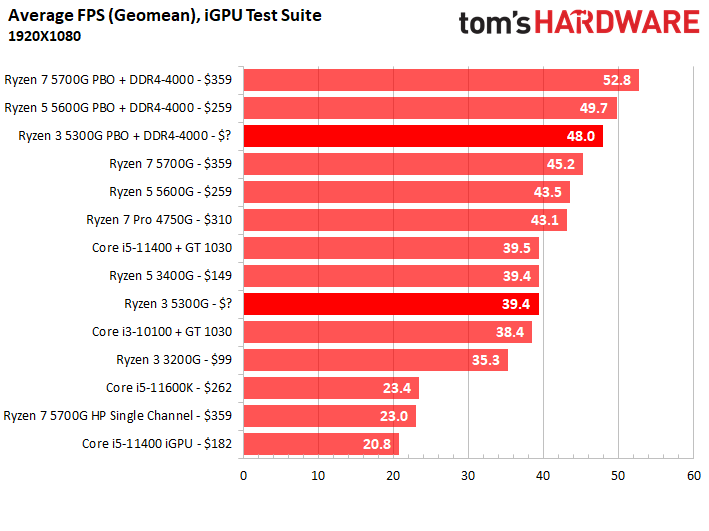
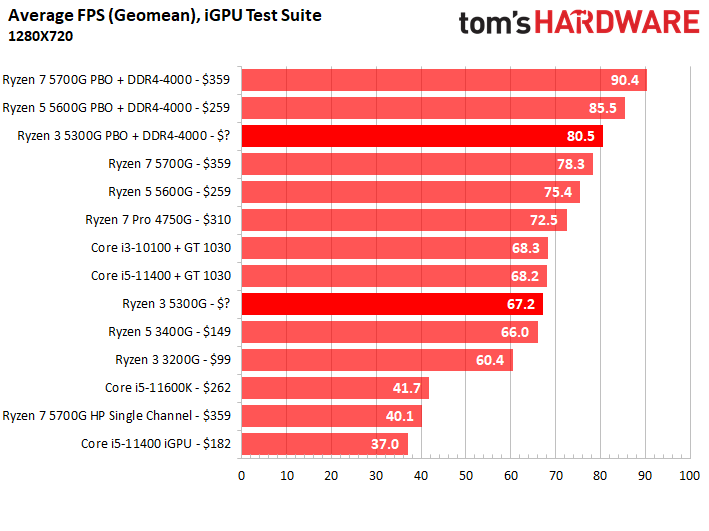
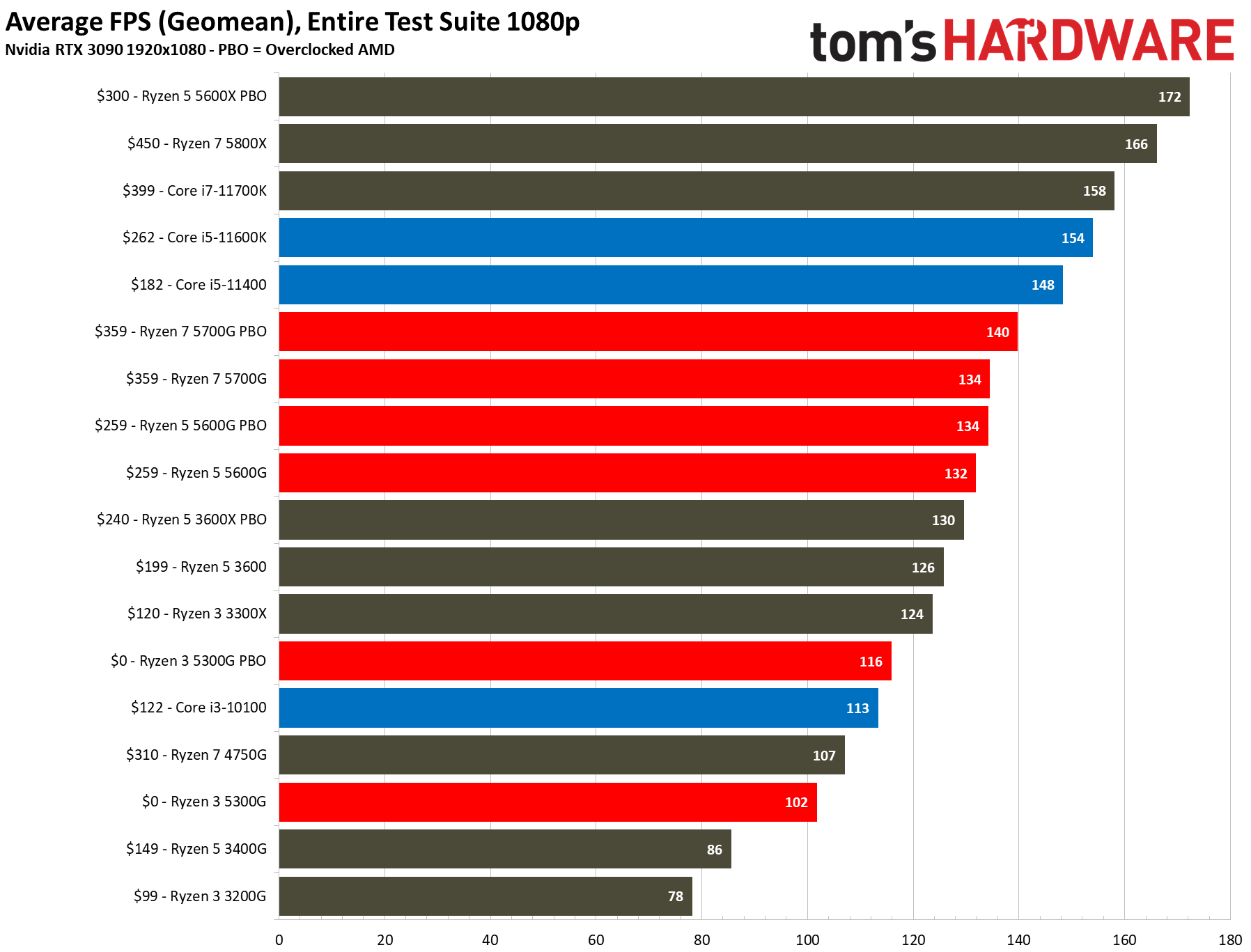

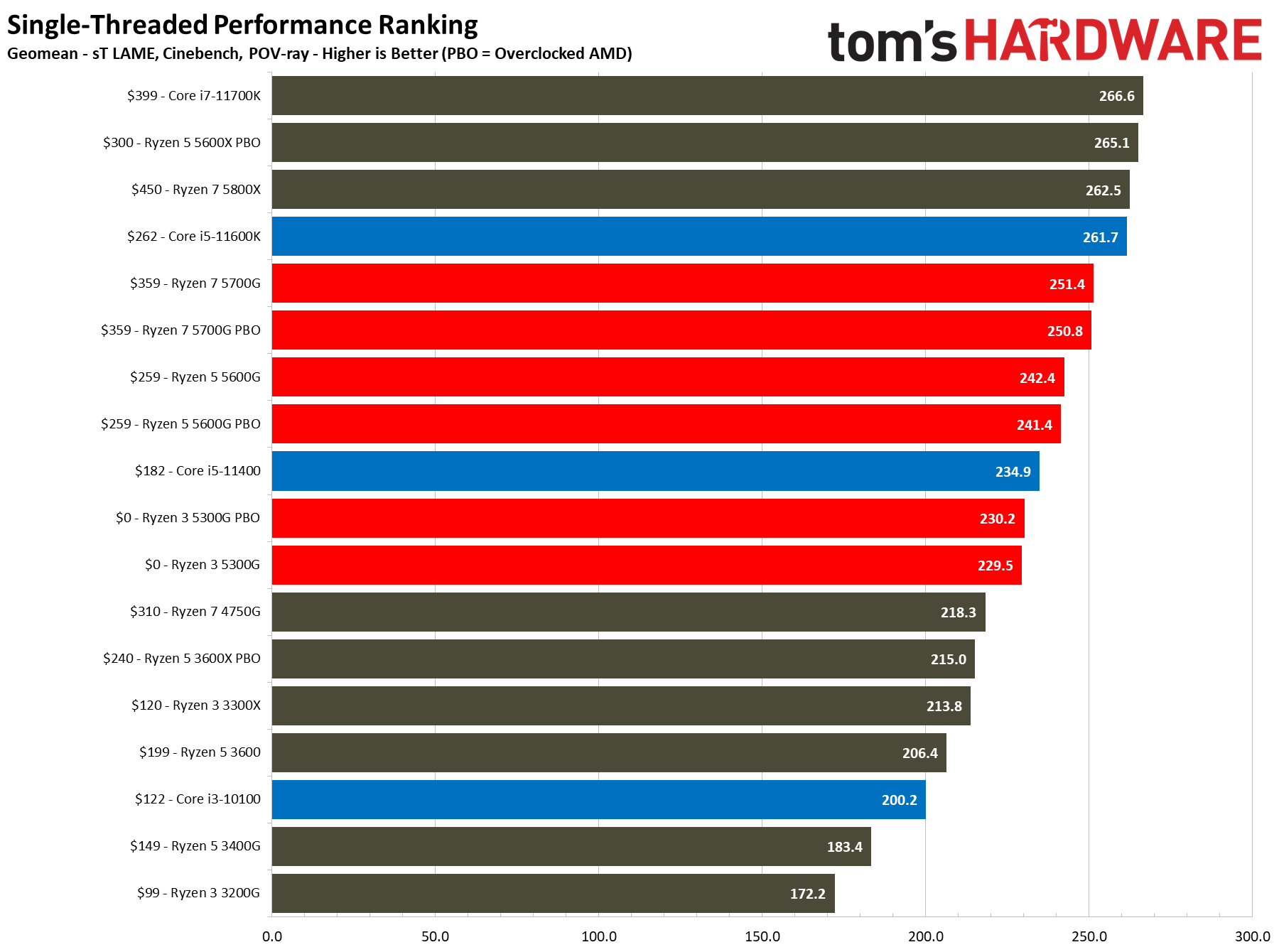
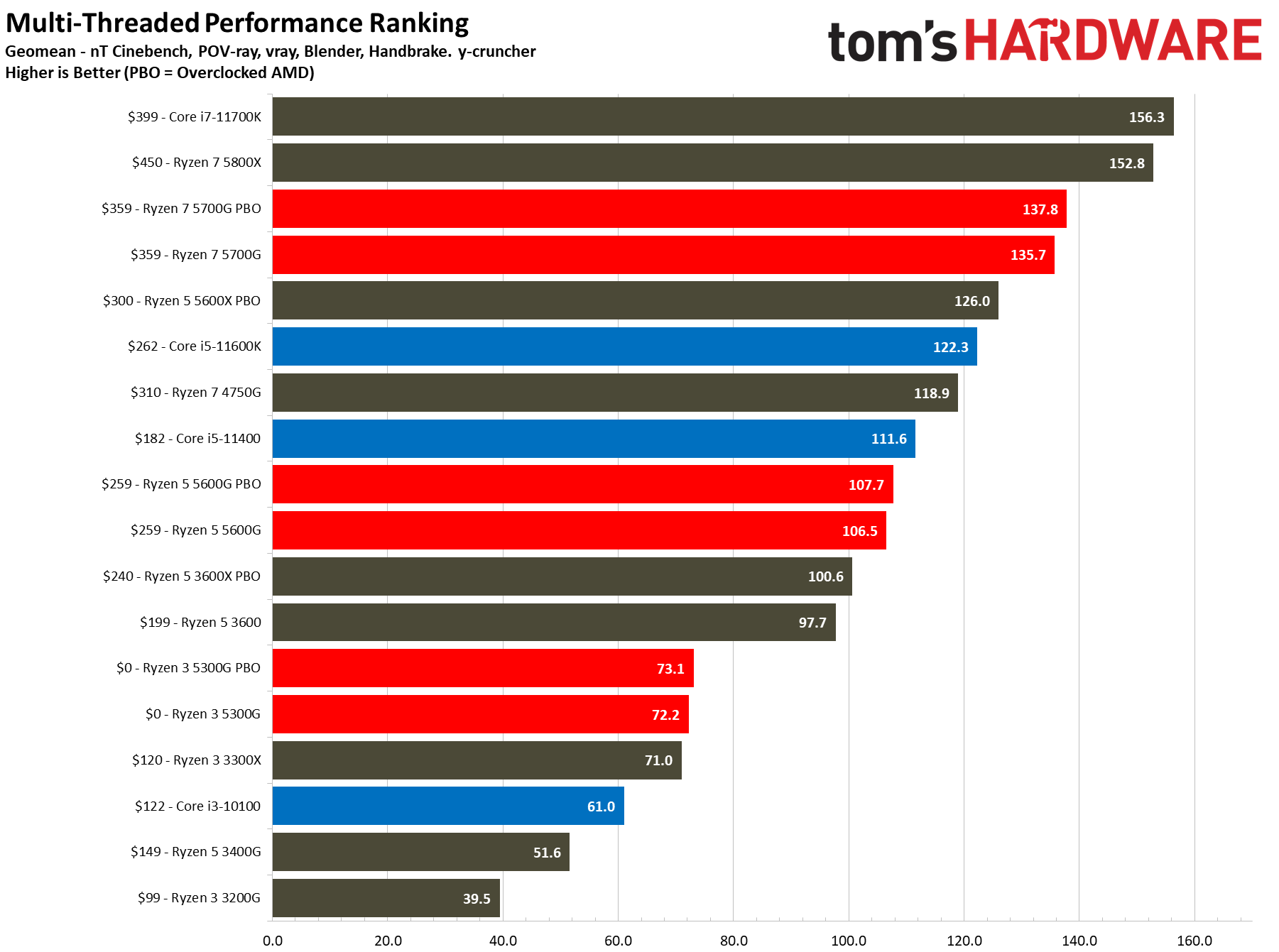
As long as you keep your expectations in check and you're willing to sacrifice fidelity and resolution, the Ryzen 3 5300G's Vega 6 graphics engine provides unmatched performance at our projected price point. At 1280x720, the Ryzen 3 5300G delivers 86% of the gaming performance of the $359 Ryzen 7 5700G, but for 60% less cash (based on our worst-case theoretical pricing). The Ryzen 3 5300G also provides 90% of the 5600G's performance, but for 40% less cash.
The 5300G provides exceptional 1280x720 gaming performance, but stepping up to 1920x1080 could result in sub-par performance in some triple-A titles if you stick with the standard presets. Naturally, some of this boils down to a subjective measure of what you gauge as playable, but be prepared to sacrifice heavily on fidelity. That said, you won't find better iGPU performance for FHD gaming at this price point.
The Ryzen 3 5300G is a great overclocker, but most folks purchasing this class of chip won't have the budget for the highest-end gear to squeeze out those last few drops of performance. This is especially important on the memory front, as increased memory throughput greatly impacts iGPU performance. Most will be best served with the cheapest DDR4-3200 kit they can find. If you're a tuner, the chip responds readily to CPU, GPU, memory, and fabric overclocking, so you'll find plenty to tinker with.
AMD's higher-end 5700G and 5600G have some utility as stop-gap gaming chips that you could use to build a gaming system now, and then complement with a discrete GPU in the future when pricing returns to normal. However, given its lacking performance with a discrete GPU, that approach doesn't make as much sense with the Ryzen 3 5300G. Yes, we would expect the chip to be paired with a drastically lower-end GPU than the 3090 we tested with, but it is clear that the Ryzen 3 5300G's halved L3 cache (it only has 8MB) severely impacts discrete GPU gaming performance. For example, the quad-core Ryzen 3 3300X with the aged Zen 2 architecture was 20% faster than the 5300G in 1080p testing, showing that the 5300G isn't great for pairing with a discrete graphics card. However, there's no doubt that AMD's marketing of L3 as "Game Cache" was spot on, and this also bodes well for the future Ryzen 3D V-Cache models that will come with up to 192MB of L3.
Get Tom's Hardware's best news and in-depth reviews, straight to your inbox.
We paired lower-end Intel chips with a cheap GT 1030 graphics card to create comparison systems with similar pricing in our reviews of other Cezanne APUs. That doesn't make as much sense when we step down to the Ryzen 3 5300G — there really isn't a cheap enough Intel chip/discrete GPU combo to compete with the 5300G, especially given the absolutely terrible pricing on low-end chips. That really wouldn't matter anyway — the Ryzen 3 5300G effectively tied the two Intel + GT 1030 combinations in most of our integrated GPU gaming benchmarks. That's incredibly impressive.
The Ryzen 3 5300G performed well in our application tests, too. For instance, the Ryzen 3 5300G is 25% faster in single-threaded and 40% faster in multi-threaded work than the Ryzen 5 3400G that also comes with four cores and eight threads.
Naturally, choosing Cezanne also means you step back from AMD's standard PCIe 4.0 support to PCIe 3.0. While PCIe 4.0 doesn't deliver any significant gains in gaming performance, that could change in the future with the Windows 11 Direct Storage feature that will utilize NVMe SSDs more fully. You'll also lose out on the (up to) doubled storage throughput for day-to-day file transfers and productivity applications.
If AMD frees the Ryzen 3 5300G from its OEM shackles, it could be the new budget champion for extreme budget gaming, small form factor (SFF), and HTPC rigs. It would also significantly lower the price of entry to the Zen 3 family. Unfortunately, the company hasn't committed to releasing it to retail.
Like Intel, AMD is prioritizing its more profitable models, so selling a chip that could siphon away from sales of higher-end chips doesn't make good business sense. AMD currently sells the Ryzen 3 5300G to OEMs, but that is part of its strategic efforts to broaden its overall presence with the high-volume OEMs that make up roughly 60% of overall desktop PC sales.
These are dire times in the value CPU market, and all of Intel and AMD's lower-end models suffer from extreme markups and poor-to-nonexistent availability. That doesn't give us much faith that we'll see the 5300G come to retail in the next few months, and definitely not in significant quantities. As such, for extreme budget gaming rigs built around integrated graphics, or if you're looking for a stop-gap chip until the GPU shortage recedes, the Ryzen 5 5600G remains the best choice for the foreseeable future.
MORE: Best CPUs for Gaming
MORE: CPU Benchmarks Hierarchy
MORE: AMD vs Intel
MORE: All CPUs Content
Current page: The Budget Market Savior...Maybe
Prev Page AMD Ryzen 3 5300G Application Benchmarks
Paul Alcorn is the Editor-in-Chief for Tom's Hardware US. He also writes news and reviews on CPUs, storage, and enterprise hardware.
-
escksu Replyhotaru251 said:i do question how pci 3.0 is a con on a cpu that is focused on being budget option.
ITs a con because all Ryzen APUs are PCIE-3.0, this means 5600G, 5700G all PCI-E3.0.....
The APU was supposdly to be a great product but AMD "castrated" it by literally halving the cache and using PCIE 3.0. On top of that, they use back Vega instead of RDNA....
Now, imagine what the APU would be like if AMD had taken a different approach. The use the same Zen3 with PCIE and full cache and drop in RDNA GPU. It would been a monster. I am find if they sell it more than the non-APU verison. -
Krotow Replyescksu said:Now, imagine what the APU would be like if AMD had taken a different approach. The use the same Zen3 with PCIE and full cache and drop in RDNA GPU. It would been a monster. I am find if they sell it more than the non-APU verison.
Apparently this will appear, but for double price :p -
Gillerer Since TSMC's N7 process is supposed to have great yields, AMD probably doesn't have many APU dies with 3+ faulty cores or 2 faulty CUs to go around.Reply
That means the only reason this 4-core alternative exists is to use up the few failed dies to satisfy their partners' greed; allowing OEMs to produce low-cost systems they can overcharge for.
AMD have stated that the 5300G will not be coming to the DYI market. Even if it did, the price would certainly not be anywhere near $150 - somewhere around $189 - $219 would be more likely, to get a similar price hike as all previous Zen 3 products.
escksu said:ITs a con because all Ryzen APUs are PCIE-3.0, this means 5600G, 5700G all PCI-E3.0.....
The APU was supposedly to be a great product but AMD "castrated" it by literally halving the cache and using PCIE 3.0. On top of that, they use back Vega instead of RDNA....
Now, imagine what the APU would be like if AMD had taken a different approach. The use the same Zen3 with PCIE and full cache and drop in RDNA GPU. It would been a monster. I am find if they sell it more than the non-APU verison.
If this had as much L3 cache as the desktop CPUs, PCIe 4 and a RDNA GPU, it certainly would be a monster - in terms of die area, power consumption and cost. No OEM would use it, or alternatively AMD would have to cut their margins severely.
This is based on what is primarily a laptop APU. Desktop comes as an afterthought, so all design decisions are made with the laptop experience and ease of integration (by OEMs) in mind. -
zodiacfml well the 3300x is now overpriced and hard to find and higher end Ryzens increased in price recently. this will fare worse.Reply -
10tacle Well heck. I am planning on building an entry level gaming PC for my 13 year old nephew as a Christmas gift (he knows of the shortages of both GPUs and PS5 consoles and the root causes of why). He'll be inheriting my old GTX 1080 Ti from my 1440p rig finally being put out to pasture, but I want to give him the peace of mind in these impossible GPU times to have a backup option for iGPU gaming should that 1080 Ti go belly up. The Ryzen 3 is right up that alley and a much better performance value than the Intel i3 but this is unfortunate. As zodiacfml said above, now the 3300x is priced into what I'd traditionally consider Ryzen 5 and Intel i5 territory. Amazon and NewEgg have it right now for $239 -- and that's a year and a half old chip originally priced at $120! I guess this is the new normal now. It used to be we could always fall back on consoles for gaming if the PC market got crazy but we don't even have that as an option now.Reply -
logainofhades Reply10tacle said:Well heck. I am planning on building an entry level gaming PC for my 13 year old nephew as a Christmas gift (he knows of the shortages of both GPUs and PS5 consoles and the root causes of why). He'll be inheriting my old GTX 1080 Ti from my 1440p rig finally being put out to pasture, but I want to give him the peace of mind in these impossible GPU times to have a backup option for iGPU gaming should that 1080 Ti go belly up. The Ryzen 3 is right up that alley and a much better performance value than the Intel i3 but this is unfortunate. As zodiacfml said above, now the 3300x is priced into what I'd traditionally consider Ryzen 5 and Intel i5 territory. Amazon and NewEgg have it right now for $239 -- and that's a year and a half old chip originally priced at $120! I guess this is the new normal now. It used to be we could always fall back on consoles for gaming if the PC market got crazy but we don't even have that as an option now.
There is always a chance of finding something, on the used market. Personally, for a new gaming rig, I wouldn't go below a 6c/12t chip. Games are becoming more core/thread heavy. -
Gillerer Replylogainofhades said:There is always a chance of finding something, on the used market. Personally, for a new gaming rig, I wouldn't go below a 6c/12t chip. Games are becoming more core/thread heavy.
If thinking of "finding something on the used market", it's important to remember that cores are not created equal, and the number of cores is not the be-all and end-all - it's the overall performance of the CPU that counts.
E.g. for a pure gaming build, I wouldn't pick Ryzen 5 1600, 1600AF or a 2600 (each 6c/12t) over a 10th gen Core i3 (4c/8t).
*
@10tacke:
Overall, the 10th gen Intel Cores are really good value right now (as long as stock lasts... which they might not until Christmas), and something like an i5-10400F or 10400 (depending on whether you need an iGPU) would be a really good gaming CPU paired with the 1080Ti.
I wouldn't count on any iGPU to be a "backup gaming option". Once you're used to dGPU performance, the most one will offer is a "backup desktop/productivity/debugging option". -
10tacle ReplyGillerer said:@10tacke: Overall, the 10th gen Intel Cores are really good value right now (as long as stock lasts... which they might not until Christmas), and something like an i5-10400F or 10400 (depending on whether you need an iGPU) would be a really good gaming CPU paired with the 1080Ti.
I wouldn't count on any iGPU to be a "backup gaming option". Once you're used to dGPU performance, the most one will offer is a "backup desktop/productivity/debugging option".
Well again we are in lean meat times. My nephew has grown up watching me PC game and upgrade PC hardware as well as get involved with PS3/4 gaming. He has had nearly a year now to fully understand what is going on with hardware shortages and to expect to be disappointed. If my 1080 Ti craps out next year and we are still in this hardware shortage mess as most analysts predict, he'll at least be informed on why he can't get a new GPU (or PS5). He'll just have to game at 720p. I'm also helping my nephew understand the term "first world problems." Problems as in be happy and make do with what you have like I grew up with and our forefathers did as well.